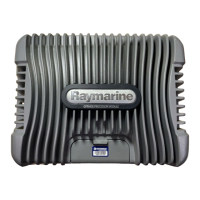G-Series Reference Manual 66
For more information about how to use AIS, see Chapter 12:Auto-
matic Identification System on page 157.
To switch AIS overlay on or off
1. Press the PRESENTATION softkey.
2. Press CHART LAYERS.
3. Toggle the AIS LAYER setting to ON or OFF.
Range rings
Range rings give you an incremental representation of distance
from your vessel to help you judge distances at a glance. The rings
are always centred on your vessel, and the scale varies to suit your
current zoom setting. Each ring is labelled with the distance from
your vessel.
To turn range rings on or off
1. Press the PRESENTATION softkey.
2. Press the CHART LAYERS softkey.
3. Select RANGE RINGS ON/OFF.
5.12 Chart mode and orientation
Mode settings control how the chart displays information. You can
synchronize the chart display with the radar application; set how
movement is represented; set the position of your vessel’s repre-
sentation on-screen, and choose your preferred chart orientation.
Find
This is a shortcut softkey that has the same effect as the FIND key
on the default toolbar. It centers the chart display on either the cur-
sor or your vessel.
Orientation
Orientation settings control the way the chart is drawn in relation to
your vessel’s position and course.
North Up (N-up)
In North Up mode, the chart is static and oriented with true north
upwards. As your heading changes, the boat symbol rotates
accordingly. This is the default mode.
Heading Up (H-up)
In Heading Up mode, the on-screen representation of your vessel
remains static, with your current heading facing upwards. When
you change heading, the chart rotates accordingly.
You cannot select Head Up when the motion mode is set to True.
To prevent continual chart rotations as the boat yaws, the chart will
only update when your heading changes by at least 10 degrees.

